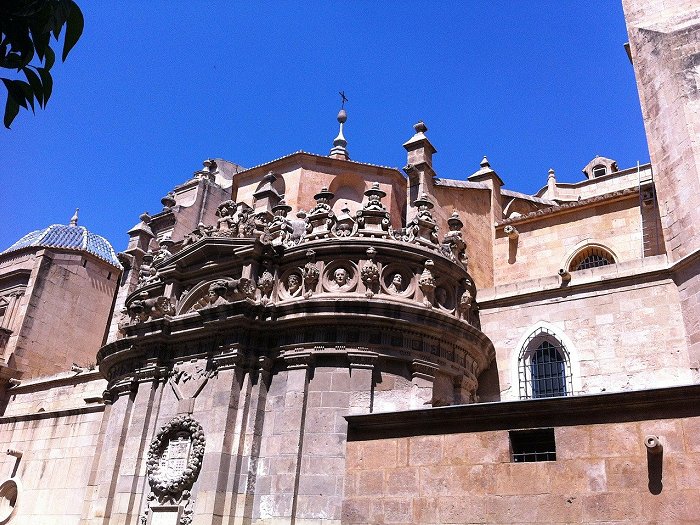
If you have been living in a residence in La Manga Club for a long time, you will have already succumbed to the charms of the region of Murcia: its high quality gastronomy, its unbeatable climate, the fantastic beaches and isolated coves, and its natural parks. However, you may not yet be aware of the richness of its heritage and historical legacy. You also may not know that it was one of the most significant Baroque sites in Spain. If you are a lover of art in all its forms, today we propose an interesting tour of the Golden Century of Murcia that, passing through churches, museums and chapels, will allow you to enjoy the architecture, sculpture and painting most characteristic of this artistic period. Get ready to spend a day surrounded by art just footsteps from your property in La Manga Club!
The Cathedral of Santa María: marvel at the Baroque grandeur of its façade
The best way to get to know Murcia’s Baroque style is to begin at the Cathedral of Murcia, located in the Plaza del Cardenal Belluga in the heart of the city’s old quarter. If you stand in front of its main façade, the imafronte, amazing in its solemnity, you can appreciate the greatest jewels of Spanish Baroque architecture and a true masterpiece. The curved lines, the twisted “Solomonic” columns, the vaults and the oval domes, are all typical features of this style characterized by vitality and movement. Construction of the façade began in 1736, following the design of engineer Sebastian Feringan, although it was Jaume Bort i Meliá, in collaboration with the architect, Pedro Fernan, who would transform the façade into an authentic and colossal altar in honour of Saint Mary. Inside the Cathedral, you will find elements of various architectural styles and, among its many chapels, two are representative of the Baroque: The Chapel of the Immaculate and The Chapel of the Socorro or San Antón.
Episcopal Palace: between Baroque and Rococo
Next to the Cathedral and the Town Hall we find The Episcopal Palace, a magnificent building of Baroque-Rococo style built in the 18th century. It comprises of one of the most outstanding architectural complexes of the city and is currently the home of the Bishop of the Diocese of Cartagena. Its main façade is located next to the Cathedral, in the bustling Plaza del Cardenal Belluga, in the heart of the old town. The back façade, named El Martillo, faces the Segura River, next to the City Hall.
Crowning the main façade, besides a large balcony with the coat of arms of Bishop Rojas y Contreras, we find two simple side doors with a moving layout. One of them, the door of the beautiful Chapel of the Apostle Santiago, is a jewel of the Baroque and the transition to the Rococo style. The Palace, moreover, is structured around a large central courtyard with a quadrangular shape. This patio is crossed on its underside by semi-circular arches located between pilasters that give rise to a porticoed gallery in the Baroque style.
The Salzillo Museum: the extravagant beauty of Baroque sculpture
Francisco Salzillo is considered one of the main exponents of Baroque and Spanish sculptural imagery. His images, their expressions, and their realistic costumes have filled Easter processions in Murcia and the churches of Murcia for centuries. For this reason, we suggest you continue the tour moving up to San Agustin’s Square where the Salzillo Museum is located, in the temple of Our Father Jesus, and where you can admire many of the works created by this Murcian sculptor.
Baroque sculpture in Murcia is characterised by the predominance of religious subjects, the realism that enhances all the details of the human body to give it expressiveness, and the polychromatic, later painted, wood that serves as the principal material.
In the interior of the Salzillo Museum, the maximum expression of this Spanish Baroque style can be seen in the “pasos” of Francisco Salzillo, the stars of the Easter procession on the morning of Good Friday in Murcia. They are “La Cena”, “La Oración del Huerto”, “El Prendimiento”, “Los Azotes”, “La Caída”, “La Verónica”, “San Juan” and “La Dolorosa”, and are the property of the Brotherhood of Our Father Jesus Nazarene. These examples of great artistic beauty can be contemplated, along with clay sketches by the brilliant sculptor, and the delicacy and uniqueness of more than five hundred tiny images, small in size, that make up Salzillo’s nativity scene.
We end today’s tour of Murcian Baroque here, but we encourage you to keep investigating, among other places, the region’s spectacular churches. They are full not only of Baroque sculpture and architecture, but also of detailed paintings that adorn altarpieces and are considered pieces of great beauty and artistic quality. Take a day away from your wonderful residence in La Manga Club to explore every corner of this city full of history, age-old traditions, and art.
Recent posts
-
08/12/25
Celebrate the 1200th anniversary of the city of Murcia from your property at La Manga Club
- 10/11/25
- 23/10/25
-
14/09/25
Thinking of buying property at La Manga Club? These 7 insights might just convince you
-
10/08/25
Looking for a day out from your home at La Manga Club? Visit the Ricote Valley and Cieza
-
18/07/25
Las Acacias: Buying a Luxury Villa in Spain’s Premier Golf Resort
-
23/06/25
Buying Property in La Manga Club: Discover the 5 Must-See Highlights of the Calblanque Regional Park
-
15/05/25
Dive just minutes from your La Manga Club home: the Islas Hormigas Marine Reserve